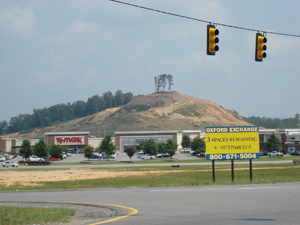
OXFORD, Ala. (AP) – A University of Alabama archaeologist has contradicted a report he signed last year claiming a stone mound in Oxford was likely made by Indians about 1,000 years ago.
The Anniston Star reports that Robert Clouse told the Oxford city council Tuesday that erosion and other natural forces likely created the mound. Clouse heads the Office of Archaeological Research at the University of Alabama and the University of Alabama Museums.
Clouse was answering questions about the mound behind the Oxford Exchange and the apparent removal of another mound at the historic Davis Farm site.
Clouse last year signed a report on the potential archaeological significance of the mound. Protests erupted last year when the city tried to remove the hill under the mound to use as fill dirt to build a Sam’s Club store nearby.
On July 10, 2009, Dan Whisenhunt filed this story for the Associated Press:
|
Goodbye Indian mounds, hello Sam’s Club OXFORD, Ala. (AP) A stone mound on a hill behind the Oxford Exchange created by American Indians 1,500 years ago will soon disappear.
And whether Oxford’s taxpayers wanted it or not, they paid for its destruction.
Workers hired by the city’s Commercial Development Authority are using the dirt from the hill as fill for a new Sam’s Club. The project has angered American Indians who, along with a Jacksonville State University archaeology professor, say the site could contain human remains.
Oxford Mayor Leon Smith and City Project Manager Fred Denney say it was used to send smoke signals.
The city’s CDA uses taxpayer money and assets to lure commercial businesses. The $2.6 million no-bid CDA contract for preparing the Sam’s site went to Oxford-based Taylor Corp. That money came from the sale of city property to Georgia-based developers Abernathy and Timberlake and from additional money provided by the city.
In Alabama, CDAs are exempt from bid laws, meaning contracts can go to whichever company the board chooses. Oxford’s CDA board and its actions have multiple connections to Smith’s political fundraising:
– At least three board members or their employers have contributed to his political campaigns.
– Taylor Corp., under the ownership of Tommy Taylor, has received thousands of dollars in city contracts for non-CDA work. Taylor donated $1,000 to Smith in 2004 and $1,000 in 2008.
– Abernathy and Timberlake donated $1,000 to Smith’s re-election campaign in 2004.
– Montgomery-based Goodwyn, Mills and Cawood donated $500 to Smith in 2004. The CDA gave the company engineering contracts for the exchange. Denney said the CDA paid the company $45,000 for engineering work, part of which paid for a University of Alabama study on the American Indian site.
The Star has so far been unable to obtain a copy of the UA study, but a letter from the Alabama Historical Commission’s deputy state historic preservation officer indicated the university did not think the site was eligible for the National Register of Historic Places. The state Historic Preservation Commission did think the site was eligible for the National Register.
Denney said the report’s authors found little at the site.
Smith has said there is nothing wrong with the connections between himself and the CDA. He has described Taylor as a, “good friend.”
Attempts to reach representatives for Taylor Corp. and Abernathy and Timberlake on Monday were unsuccessful.
The Birmingham office of Goodwyn, Mills and Cawood declined comment. CDA members contacted by The Star declined comment, referring questions to board chairman Dwight Rice. Attempts to reach Rice on Monday also were unsuccessful.
Chervis Isom, a Birmingham attorney representing Abernathy and Timberlake, said the company isn’t involved with the hill or the fill dirt.
“If the dirt were contaminated in some way we’d certainly have an interest in that,” Isom said. “Where the CDA got the dirt I’m not sure. We don’t have any control over that.”
He added he does not think there is any problem with the dirt.
Denney said workers will remove about one-third of the hill and cover it with grass. The city eventually will develop commercial business on what remains of the hill, he said.
A September 2008 proposal by Taylor Corp. describes the demolition in vague terms.
“This item includes undercutting two building pad footprints …” the report reads. “The City has agreed to let us spoil the undercut material on their property across the new bridge.”
Denney said the line in the proposal refers to the hill.
“The agreement was we’d furnish the soil,” Denney said. “The city would furnish them a place to get it.”
The City Council transferred the property containing the hill to the CDA in February. Councilwoman June Land Reaves, who voted against the transfer, said she did not understand the hill property was a part of it.
“I never heard any discussion about dirt being taken from the hillside or a reason why that was being done, but it seems to me like a lot of cities capitalize on the history they have … but (we do not seem) to do that,” she said.
Council President Chris Spurlin said it’s too late for the City Council to intervene at the site.
He said he hated the bad publicity, but said there is no proof the site holds human remains.
“The CDA has the authority,” Spurlin said. “They’re trying to do what’s best for the city. I don’t see no reason in buying fill dirt from someone when we have that hill available.” Copyright 2009 Associated Press. All rights reserved. This material may not be published, broadcast, rewritten, or redistributed.
___ Information from: The Anniston Star, http://www.annistonstar.com/ Copyright 2010 Associated Press. All rights reserved. This material may not be published, broadcast, rewritten, or redistributed. AP-CS-01-27-10 0852EST
|

